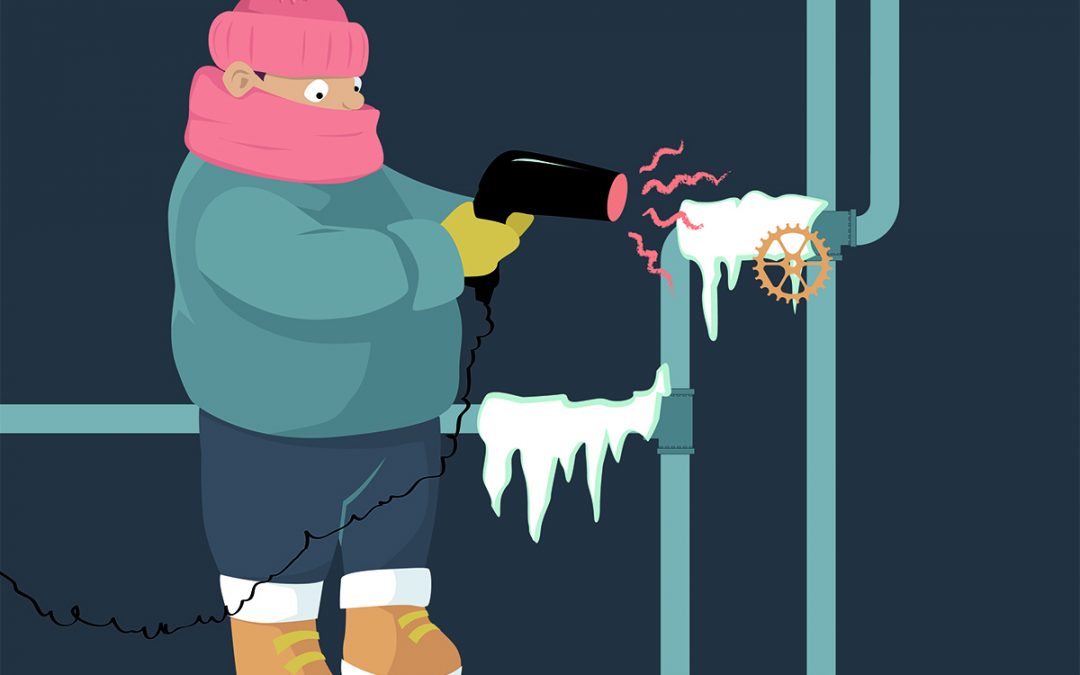It’s finally Ohio’s most well-known season. The season where traffic comes to a halt from ice-related accidents, where our kids wake up early to see if it’s a snow day, and where homeowners live in fear of frozen pipes bursting.
But you don’t have to be in constant worry of water damage or replacing broken pipes if you know what causes the problem and how to prevent it from happening.
Let’s take a look.
Why Do My Pipes Freeze in the Winter?
Pipes are like anything else exposed to the cold. When they get to a low enough temperature, they freeze. However, because the water is almost always in motion, it takes much longer to freeze. That’s why lake or pond water freezes over much more quickly than bodies of running water such as rivers.
So when we get alerts for winter storms or unusually low temperatures, we need to take precautions.

Why Do Pipes Burst when They Freeze?
Water in pipes works the same way as water in any other location. Let’s use your freezer as an example.
You put an ice cube tray in overnight to solidify for tomorrow night’s holiday party. You fill each slot almost to the top, but not quite all the way. The next morning you pull them out and see that the water has overflowed, and the individual cubes are now one uniform piece.
This happens because water expands when it freezes. The molecules slow down and push away from each other as the temperature drops, causing the water to cover more area.
When the water is in an ice cube tray, it can easily expand upwards where there is space for it. However, in your water pipes, there’s nowhere to go but out.
The pressure from the building ice weakens the structure of the pipe and eventually splits a hole in it, allowing the expanding water to pour out.

How to Prevent Pipes from Bursting
If you turn on a faucet and notice that the water is not flowing freely, you probably have a frozen pipe on your hands. You want to take steps right away to get the frozen area back to normal before you have a burst pipe.
- Before the weather gets too cold, locate your main water shutoff valve. You’ll want to know exactly where it is in case you don’t catch the line before it bursts and can shut off the water supply quickly. Make sure it works before you attempt to thaw the line. If no water is flowing and the line is frozen, you may want to have a plumber thaw the line for you in case it is already damaged. You won’t know until you thaw it in most cases, and then it may be too late. The thaw is when emergency situations occur.
- The pipes closest to exterior walls and the outside world are most susceptible to freezing. That includes supply lines for pools and water sprinklers, lines that run through your basement or attic, and even pipes that run to the kitchen. Leave the faucet running a little to help alleviate some of the pressure building up in the pipe. Please make sure your sink is draining great if you use this method. Keeping cabinet doors open with sinks on outside walls is also helpful.
- If you notice an issue with one frozen pipe, you probably have another somewhere. Let all the faucets in your home run for a couple of minutes to see where other problem areas may lie.
- Apply low heat to the frozen section of the water line to melt ice forming inside. Try towels soaked in hot water or a hair dryer. Do not use an open flame to thaw the pipe under any circumstance. It can damage the pipe or ignite any flammable materials nearby.
- If you can’t reach the pipes, or if your pipe has already burst, contact a professional plumber right away. They’ll give you steps to take until they can come out and inspect or replace the pipes.


Recent Comments